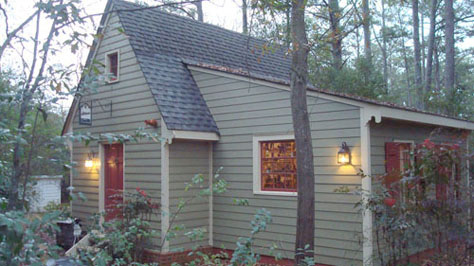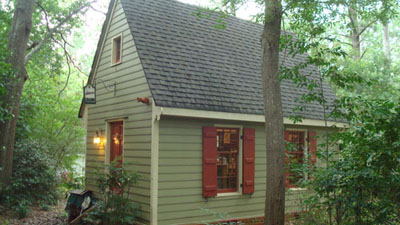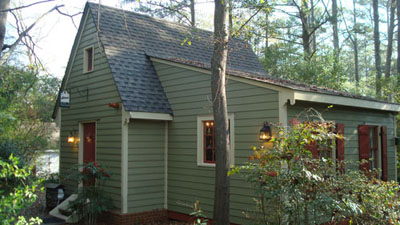
Here's My Workshop!
by Kerry Lancaster
Jonesboro, GA
Note: click any picture to see a larger version.
In 1967 my wife and I visited Colonial Williamsburg for the first time. We fell in love with it
and have made many, many trips back to that place of history.
The love of the architecture in Colonial Williamsburg inspired us when we built my workshop in
1973. We knew we wanted an authentic 18th Century Williamsburg house and wanted the shop to
complement our home if and when we were able to build our dream. The shop was built three years
before the house ever came out of the ground because my theory was, “better built my shop first or
it may never happen.” So the project was birthed.
I drew the plans for the original part of the workshop. It was a simple 12’ x 20’ shop that
would provide all the room necessary for my shop needs, so I thought. My wife and I literally built
the structure ourselves, following the instructions from a book my father-in-law had given us right
after we married, “How to Build Your Dream House for $3,500,” published in 1950. We would sit in
the woods and read that book, then we would get up and follow the directions. We didn’t have a clue
what we were doing, but we managed to build that first structure using the materials we wanted to
use when we would eventually build our house. My wife put the original roof on the shop, five
pieces at a time because she couldn’t lift more roofing than that.

Jumping ahead to last year. I was so squeezed in that original shop that I had to use my table
saw as a work bench. My first love is making Windsor chairs and reproduction primitive 18th century
furniture. The need for more space became so great we decided to build a 12’ x 16” addition to my
shop, which would almost double the square footage of my workshop. However, this time I hired the
son of the builder that built our house. He gave me a bid that fit our budget because of the slow
building economy.

In August 2010 the addition was added to the original shop we built in 1973. We decided to made
the opening between the old and new the width of the original windows and the wall between them,
which is about ten feet. We recycled the windows using them for the side windows. I made a trip to
a local salvage yard and found half of an old window sash that I framed for the window on the front
of the addition, giving me more natural light for the shop. We also recycled the shutters and
hardware. We left the original lapped siding of the shop exposed in the new addition, giving it the
added-on look inside as well as outside that we wanted.
In October we made another trip to Colonial Williamsburg with our focus on photographing the
inside of workshops. There was a common theme in the workshop, all their tools were on the wall for
easy access. After returning home I started gathering all my hand tools to hang on the wall. Some
of these tools belong to my grandfather, who was a blacksmith at the East Point (Georgia) Buggy
Works. I found an old tool box of his tools when we cleaned out my mom and dad’s garage in 1989.
They had been stored in the attic of the workshop all these years. The tools hanging on the wall
are so handy when working on projects, I don’t have to plunder through drawers looking for a tool,
they are all right on the wall. We can learn so much from history and our forefathers. My first
project was to build a
Roubo
workbench
, which is another story for another day. I have since
completed a corner cabinet, which conceals the TV, and a wall cabinet to store my books and
magazines.
After painting the new addition the original structure looked old and dingy so we decided to give
the old shop a facelift with a new coat of paint. It is amazing what a little paint and my wife’s
organizational skills can do for an old shop. This is truly a dream come true for me. I can
actually turn around in my shop and I have sufficient room to work. Now I look forward to many
hours working in my shop. My wife affectionately calls it my cave.
Thanks to Highland Woodworking for the great tools and products to help make all my wood projects
possible. My wife says I look for excuses to make a trip. In fact, when we have visitors come to
Atlanta for a visit, we always include a trip to Highland Woodworking, my favorite Atlanta landmark.
You can email Kerry at
ktltbl@gmail.com
.
Return to front page
